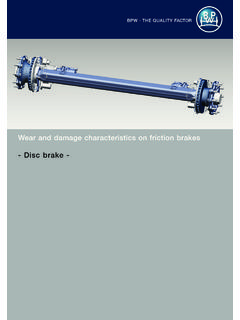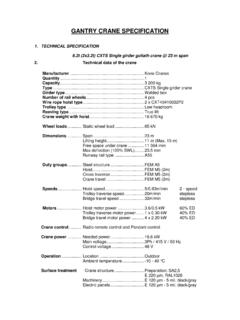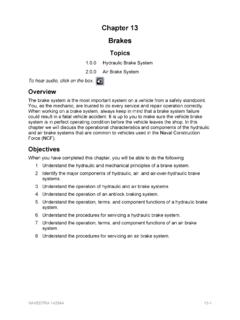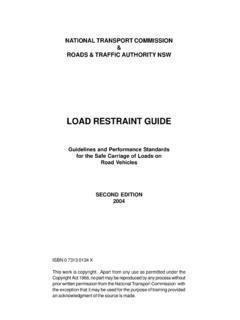Transcription of Calculating Train Braking Distance - CRPIT
1 Calculating Train Braking Distance David Barney, David Haley and George Nikandros Signal and Operational Systems Queensland Rail PO Box 1429, Brisbane 4001, Queensland, Australia / / Despite the obvious criticality of the required Braking Abstract Distance , the calculation process traditionally used within The paper discusses the development of an IBM PC 1 based QR, and for that matter most other railways, is not as tool, for Calculating Train Braking distances for various Train robust as it perhaps should be. classes on a rail network. There is discussion on current industry practice and the limitations of that practice, the concept of the The purpose of this IBM PC based tool is to: tool itself, including the assumptions made, the strategy adopted assist the signal designer to provide an adequate to minimise the risk of incorrect calculations, and the results of Distance for the safe stopping of trains operating on a adopting that strategy.
2 Given line whilst at the same time maximising line Keywords: Train , Braking , Distance , calculation, railway. capacity;. put in place controls to ensure that the data used for 1 Introduction the calculation is verified and traceable, and any For trains to safely travel on a railway, trains must be changes controlled;. provided with sufficient Distance in which to stop. allow the ready evaluation of a new Train by Allowing too long a Distance reduces the capacity of the performing multiple calculations in one execution;. line and hence the return on rail infrastructure investment. Too short a Distance and collisions would occur, because readily highlight those Limits of Authority that need the Train would not be able to stop within the available to be relocated to allow for changes in speed or Train Distance and would therefore occupy a section of track Braking performance.
3 That could be allocated to another Train . Consequently it is important that the Distance be adequate, but not overly so. In Section 3 we describe common industry practices and Figure 1 shows the relationship between Braking Distance the limitations of those practices. In Section 4 we provide and headway which is a measure of capacity. an overview of the tool requirements and implementation strategy. In Section 5 we conclude by discussing the Traditionally, the calculation of the required Braking effectiveness of that strategy. Distance is on a per Limit of Authority basis. The task is further complicated if there are many trains with different 2 Definitions Braking and ride performance characteristics operating on the same section of track, because for safety, the Distance ATP (Automatic Train Protection) is a predictive needs to be the longest of all the different trains.
4 The enforcement system which continuously monitors the calculation needs to be repeated for every Train type and speed of a Train in relation to either a target speed, which every approach path to that Limit of Authority. for a Limit of Authority would be zero, or a target Distance , and intervenes such that the Train is prevented Within Queensland Rail (QR), there are currently some from passing a Limit of Authority or exceeding a speed 40 different Train types defined and some 7000 locations limit. where trains may be required to stop. For some of those 7000 locations, there are many different approach paths. Braking Distance is the Distance the Train travels from Every time there is a change involving an increase in Train when the Train driver makes a full-service brake speed or a reduction in the Train Braking performance, the application to when the Train stops (Fig 1).
5 Calculation must be repeated for every signal involved for COTS (Commercial Off the Shelf) it is a phrase used that Train type. This often means thousands of to refer to commercially available products being used calculations. as is . Full-Service Brake is the maximum deceleration rate 1. deceleration so as to minimise the risk of injury to Registered trademark of International Business passengers or damage to goods or cause damage to the Machines Corporation Train . Copyright 2001, Australian Computer Society, Inc. This Limit of Authority is a location along the railway where paper appeared at the 6th Australian Workshop on Safety a Train 's current authority to move ends.
6 It is usually Critical Systems and Software (SCS'01), Brisbane. Conferences delineated by a signal, passive sign, or track kilometrage. in Research and Practice in Information Technology, Vol. 3. P. Lindsay, Ed. Reproduction for academic, non-for profit purposes permitted provided this text is included. G Y R. Sighting Braking Distance Braking Distance Overlap Distance Headway Distance Figure 1: Standard 3 Aspect Sequencing used in QR. (The paper relates to the calculation of the distances labelled Braking Distance ). Train Type a Train is characterised by its maximum the Train 's acceleration rate (a) (deceleration is negative permissible speed, its deceleration rate, the time delay for acceleration) and the stopping Distance (S).
7 The deceleration rate to become effective, its length and The change in kinetic' energy relates to the change in the its permission to exceed certain classes of track speed Train 's speed the difference of the speed at which restrictions. Passenger trains and bulk commodity trains deceleration began (U) and the at stop' speed 0. coal, mineral, grain have certain nominal lengths depending on where they operate. General freight trains The change in potential' energy relates to the change in can be of any length up to a specified maximum for a height of the Train 's centre of mass due to the gradient of particular line. To cater for this variation long' and the track the difference in height at which short' types are defined.
8 Note: The brake delay time deceleration began (h1) and the its height at the stopping varies with Train length the longer the Train , the longer point (h2). the delay. Mathematically this can be expressed as: m*(a)*S + *m*(U2) + m*g*(h1-h2) = 0 (1), 3 Calculating Braking Distance where g' is the acceleration due to gravity and h2 h1. Mass is common in all the terms in the equation, and Influencing Factors therefore can be cancelled out. This suggests that mass has no direct effect on the stopping Distance . However, Braking Distance depends on: mass has an effect on the stopping Distance as the location the speed of the Train when the brakes are applied; of the Train 's centre of mass varies with the mass distribution.
9 Mass also affects the deceleration rate of a the deceleration rate available with a full-service particular item of rolling stock. For freight wagons, where brake application, which varies according to the the mass can vary from no load to full load, there are two coefficient of friction between wheel and rail; levels of brake force used empty and loaded . The the delay from when the brakes are commanded by design of the brake system is such that as the load the Train driver to when they are actually become increases, there is a point where the force changes from effective (brake delay time); empty to loaded . For Braking Distance calculations the lowest deceleration rate is used to calculate the the state of the wear of the brake pads and the air deceleration rate for the complete Train .
10 Pressure available in the brake cylinders;. The change in height relates to the track gradient. The the geography of the track, in particular the track track gradient is the change of vertical height over the gradient the Train travels over from when the brakes FRUUHVSRQGLQJ FKDQJH LQ KRUL]RQWDO GLVWDQFH L H WDQ . are commanded to where the front of the Train stops; ZKHUH LV WKH DQJOH RI VORSH )RU VPDOO ZKLFK LV WKH. FDVH IRU UDLOZD\V PRXQWDLQ UDFN UDLOZD\V DVLGH WDQ . the mass distribution of the Train . HTXDOV VLQ 6LQ LV WKH FKDQJH LQ KHLJKW K2 -h1) over the stopping Distance (S): The Effect of Train Mass (h2-h1 6 VLQ 6 WDQ (2).







